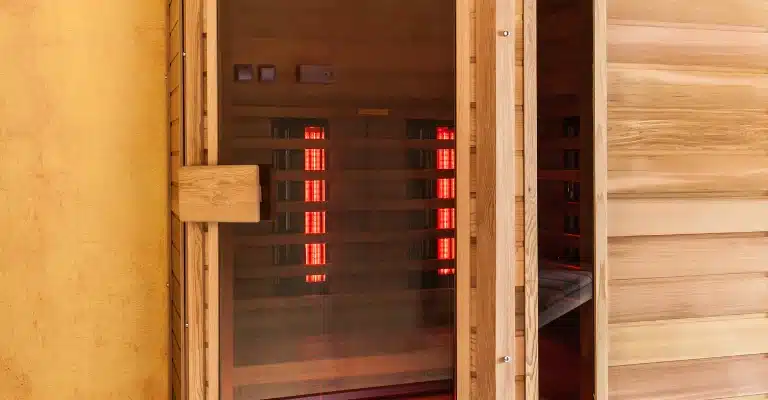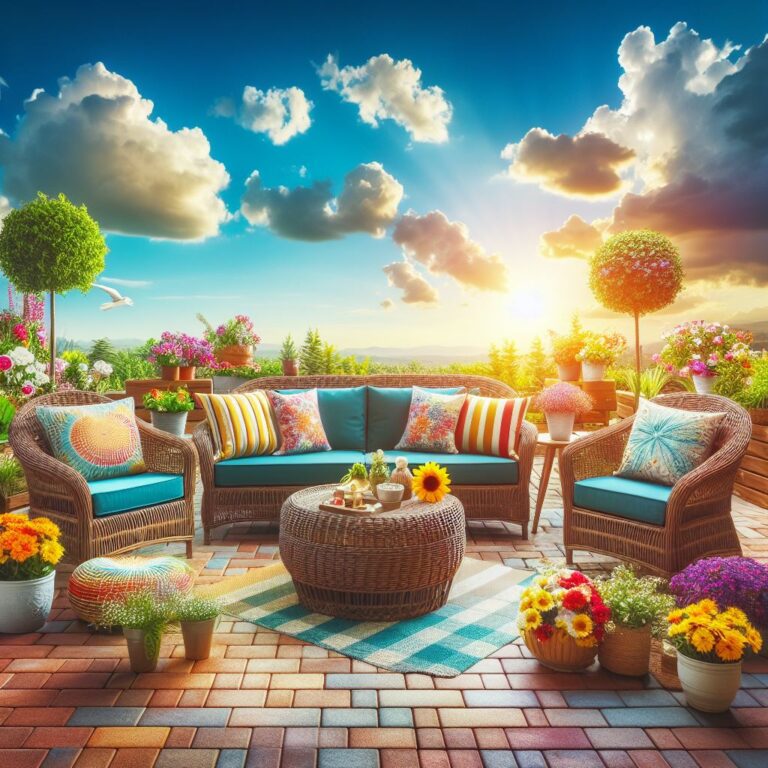8 Most Durable Outdoor Furniture Materials
Choosing the best material for outdoor furniture can feel like a tricky puzzle, especially if you’ve ever had your outdoor setup fade, rust, or become uncomfortable over time.
You’re probably asking yourself, “What’s the most durable material? Will it survive the rain? How can I keep it looking good without too much maintenance?”
We get it. Whether you’re sprucing up your patio or upgrading your garden space, finding furniture that can stand up to the elements without sacrificing comfort or style is no easy task.
Perhaps you’ve already dealt with a rusting metal chair or cushions that became soggy after a rainstorm. These frustrations are common but avoidable!
In this guide, we’ll break down the best outdoor furniture materials—from weather-resistant fabrics to long-lasting options that balance durability and design.
By the end, you’ll have the insights you need to make an informed choice and enjoy an outdoor space that’s both comfortable and built to last, no matter what nature throws at it.
8 Outdoor Furniture Materials
Outdoor furniture must endure a variety of conditions—rain, sun, wind, and even snow—so selecting the right material is key. Below, we break down the most durable materials that balance style, comfort, and longevity for your outdoor spaces.
1. Teak Wood
- Teak is renowned for its strength and natural resistance to moisture, making it one of the best choices for outdoor use. It withstands full sun, rain, and even pests. With minimal maintenance, teak develops an attractive patina over time, enhancing its beauty.

2. Aluminum
- Lightweight, rust-resistant, and durable, aluminum is perfect for humid or coastal climates. It’s easy to maintain and doesn’t need constant care, making it ideal for rainy conditions and sunny locations.
3. All-Weather Wicker
- Synthetic wicker offers the classic charm of natural wicker with the added benefit of being resistant to moisture, UV rays, and harsh weather. It’s a go-to option for those looking to blend style with resilience.
4. Steel
- Heavier than aluminum, steel is highly durable but prone to rust without a protective coating. It’s ideal for windy areas due to its weight, but you’ll need to ensure it has a weather-resistant finish for long-lasting protection.
5. Plastic (HDPE)
- High-density polyethylene (HDPE) plastic is not only eco-friendly but also tough. It resists cracking, fading, and peeling, even under harsh sunlight. This makes it a popular, low-maintenance choice for outdoor spaces.
6. Rattan
- While natural rattan can be vulnerable to moisture, synthetic versions are highly durable. It provides a stylish and comfortable option for garden furniture, offering a modern look with long-lasting durability.
7. Olefin Fabric
- Known for its resistance to UV rays and moisture, Olefin fabric is one of the best choices for outdoor cushions. It dries quickly, is comfortable, and remains vibrant after prolonged sun exposure.
8. Mesh Material
- Mesh fabrics are perfect for hot climates, as they’re breathable, quick-drying, and ideal for lounging in the sun. Their flexibility and durability make them popular in patio seating and outdoor lounges.
Types of Outdoor Furniture Materials
A. Wood

1. Teakwood
- Pros:
- Renowned for its durability and strength, teakwood’s high oil content is a natural barrier against rot, decay, termites, and harsh weather conditions.
- Its natural beauty is a draw for many, with a graceful aging process that adds character to the furniture over time.
- Cons:
- The high cost of teak can be a deterrent for some, reflecting its premium status in the furniture market.
- Limited availability due to sustainability efforts can affect accessibility and price.

2. Ipe
- Known for its toughness and longevity, Ipe is another excellent choice for outdoor furniture. It shares many of the beneficial properties of teak, such as resistance to weather and pests.
| Pros | Cons |
|---|---|
| 1. Durability: Can last up to 75 years. | 1. Hardness: Difficult to work with, may dull tools. |
| 2. Strength: High Janka hardness rating. | 2. Cost: Often more expensive than other hardwoods. |
| 3. Resistance to Rot and Insects: Naturally resistant. | 5. Maintenance: Some are required over time. |
| 4. Aesthetic Appeal: Smooth appearance, uniform grain. | 4. Environmental Impact: Mixed sustainability ratings. |
| 5. Fire Resistance: Higher resistance compared to other woods. | 5. Maintenance: Required over time. |
- Can Ipe be used for furniture? Yes, Ipe wood is often used in furniture making due to its durability and strength. It’s particularly suitable for outdoor furniture as it is naturally rot and insect-resistant.
- Is ipe wood waterproof? Ipe wood is resistant to moisture and water but not completely waterproof. Prolonged exposure to water can still cause damage, so it’s recommended to apply a water-repellent finish if it is frequently exposed to water.
- Is teak stronger than Ipe? Ipe is stronger than teak. It has a higher Janka hardness rating, making it more resistant to physical damage. Ipe’s Janka rating is 3,500 lbf compared to teak’s 2,300 lbf.
- How long does ipe wood last? Ipe wood is incredibly durable and can last up to 75 years, depending on exposure and treatment. It’s known for its longevity, especially in outdoor applications.
3. Other Wood Options:
Various other woods like cedar, eucalyptus, and shorea are also suitable for outdoor furniture, each with unique properties and considerations.
| Wood Type | Pros | Cons |
|---|---|---|
| Cedar | Naturally rot-resistant and repels insects, beautiful color and grain, lightweight and easy to work with. | May require annual treatment with a water-based sealant, vulnerable to excessive moisture without treatment. |
| Eucalyptus | Can show moderate checking as it ages and requires regular treatment to maintain its appearance. | Durable and strong, resistant to rot and decay, and a beautiful reddish color that darkens with age. |
| Shorea | Can show moderate checking as it ages and requires regular treatment to maintain its appearance. | Can show moderate checking as it ages and requires regular treatment to maintain appearance. |
B. Metals
- Aluminum
- This metal is favored for its lightweight, rust-proof nature and temperature resistance, making it ideal for outdoor settings where furniture needs to be moved or stored seasonally.
- Wrought Iron
- While heavy and sturdy, wrought iron furniture can be susceptible to rust if not properly treated or covered, requiring more maintenance.
- Galvanized Steel
- Galvanized steel offers added protection against rust, but it can still be prone to scratches and dents, which may lead to corrosion over time.
| Metal Type | Pros | Cons |
|---|---|---|
| Aluminum | Lightweight, rust-proof, temperature resistant. | Less sturdy than heavier metals, may dent more easily. |
| Wrought Iron | Heavy and sturdy, classic aesthetic. | They are prone to rust if not treated and are heavier to move. |
| Galvanized Steel | Added rust protection, durable. | Can scratch and dent, leading to potential corrosion. |

C. Other Materials
- All-Weather Wicker
- This synthetic material mimics the look of traditional wicker but stands up better to the elements, making it a popular choice for outdoor furniture.
- Plastic
- Often used for its versatility and low cost, plastic furniture can range from basic designs to high-quality pieces made from recycled materials.
| Material | Pros | Cons |
|---|---|---|
| All-Weather Wicker | Can be expensive compared to some other materials and may require wiping and care to maintain appearance. | Mimics traditional wicker with better durability, is resistant to mold and mildew, is lightweight and versatile, and requires little to no maintenance. |
| Plastic | Inexpensive and versatile, low maintenance and easy to clean, available in various designs and colors. | Can be expensive compared to some other materials, and may require wiping and care to maintain appearance. |
Check out our comprehensive table for a quick overview of popular outdoor furniture materials, including wood, metals, and synthetics. Compare average prices and popularity ratings to find the perfect fit for your outdoor space.
| Material | Average Price (USD) | Popularity Rating |
|---|---|---|
| Teakwood | $22-$24/sq.ft | ⭐⭐⭐⭐ |
| Ipe | $3.50-$5/sq.ft | ⭐⭐⭐ |
| Cedar | $15/sq.ft | ⭐⭐⭐ |
| Eucalyptus | $280/cubic meter | ⭐⭐⭐ |
| Shorea | Benches: ~$634.32, Tables: ~$420.48 | ⭐⭐⭐ |
| Aluminum | $1.15/lb | ⭐⭐⭐⭐ |
| Wrought Iron | $100-$1,000 per piece | ⭐⭐⭐ |
Check out our 10 Secrets to Creating the Perfect Patio Paradise You’ll Love
Factors to Consider When Choosing Outdoor Furniture Materials
When choosing outdoor furniture, it’s essential to weigh the cost, maintenance, and aesthetic to make the best choice for your space and lifestyle. Whether you’re looking for something low-maintenance or prefer a specific style, there are materials out there to meet your needs.
A. Durability
- The longevity of outdoor furniture is greatly affected by the material it’s made from. Materials like teak and high-density polyethylene (HDPE) are known for their ability to withstand the elements and last for many years.
B. Aesthetic Appeal
- The material you choose contributes significantly to the overall look of your outdoor space. Whether you prefer the natural warmth of wood or the sleek modernity of metal, the material should complement your style and the ambiance of your outdoor area.
C. Maintenance
- Some materials require more upkeep than others. Consider how much time and effort you will invest in maintaining your furniture. For example, teak requires regular oiling to maintain its color, while aluminum and recycled plastics need minimal care.
D. Cost
- The initial investment and the long-term value of the furniture are also important. While some materials may be more expensive upfront, their durability and low maintenance can make them more cost-effective over time.
By weighing these factors against your personal needs and preferences, you can choose the best materials for your outdoor furniture, ensuring a beautiful, functional, and lasting addition to your home.
For more about outdoor relaxation & wellness, you can visit Hot Tub Patio. On the other hand, check out Garden and Patio to improve your outdoor space with landscaping and beautification.
Best Outdoor Furniture Materials for Different Climates
Not all materials perform equally in every climate. Whether you’re dealing with humid coastal areas or dry, hot deserts, choosing the right material for your climate ensures your furniture lasts longer and looks great year-round. Here are the best options based on where you live:
Wet and Humid Climates
Key Problem: Moisture and humidity can lead to rust, mold, and deterioration of furniture.
- Aluminum: This metal is naturally resistant to rust and corrosion, making it perfect for regions that experience a lot of rain or high humidity. Powder-coated aluminum offers even more protection, ensuring your furniture won’t degrade over time.
- Synthetic Wicker: Unlike natural wicker, synthetic wicker (usually made from resin) resists moisture and mildew, making it a fantastic option for humid environments. It also maintains its shape and color, even when exposed to constant dampness.
Dry and Hot Climates
Key Problem: Intense sun and dry heat can cause materials to fade, crack, or warp.
- Teak: With its natural oils, teak is exceptionally durable in hot and dry climates. It resists cracking and warping, even under prolonged sun exposure. Over time, it weathers into a beautiful silvery-gray finish, adding to its charm in dry climates.
- Wrought Iron: Although it can be heavy, wrought iron is incredibly strong and can withstand the extreme temperatures of hot climates. Its ability to hold up under direct sun without becoming brittle makes it a top choice for desert regions.
Coastal Areas
Key Problem: Salty air can corrode materials, leading to rust and degradation.
- Marine-Grade Polymer (MGP): This material is specifically designed to endure salty air and sea spray. It doesn’t absorb moisture, ensuring it won’t warp or rust, making it ideal for coastal homes.
- Plastic (HDPE): High-density polyethylene plastic is highly resistant to saltwater corrosion and doesn’t fade from UV exposure. It’s a great choice for homes near the coast where salty air can be harsh on traditional materials.
Cold and Snowy Climates
Key Problem: Extreme cold can cause materials to crack, and snow can lead to moisture damage.
- Steel (Powder-Coated): In cold climates, powder-coated steel can endure freezing temperatures and heavy snow. Ensure the coating remains intact to avoid rust. This material’s weight makes it ideal for withstanding high winds and snowstorms.
- Concrete (GRC): For those seeking furniture that can stay outside year-round, Glass-Reinforced Concrete (GRC) is a solid option. It doesn’t crack or degrade in freezing temperatures and requires minimal upkeep during the winter months.
Check out our Patio vs Balcony: Choosing Your Outdoor Oasis
Choose the Right Outdoor Furniture Material
Selecting the best outdoor furniture material involves balancing your local weather conditions, style preferences, and the amount of maintenance you’re comfortable with. Here are some key factors to consider when choosing the right material for your outdoor space:
Budget
Key Problem: How much are you willing to spend on durable and stylish outdoor furniture?
- Plastic or Aluminum: These materials are often more affordable, making them great choices if you’re working with a smaller budget. Despite their lower price point, they can still provide the durability you need for various climates.
- Teak or Steel: If you’re willing to spend a bit more for a higher-quality look and feel, materials like teak or steel may be worth the investment. While they come at a higher price, their longevity and durability often make up for the initial cost.
Maintenance
Key Problem: How much time and effort are you willing to invest in maintaining your furniture?
- Low-Maintenance Materials: If you want furniture that requires little upkeep, aluminum and plastic are excellent choices. Both materials resist rust and don’t need regular treatments. Simply wiping them down now and then keeps them looking clean and fresh.
- High-Maintenance Materials: Materials like wood, such as teak or cedar, require regular oiling, staining, or sealing to maintain their durability and appearance. If you love the look of natural wood and don’t mind spending extra time on care, these materials can last for many years with the right maintenance routine.
Style and Aesthetics
Key Problem: Do the materials match the look and feel you’re going for in your outdoor space?
- Modern Look: For a sleek, modern aesthetic, aluminum and steel often provide clean lines and a contemporary feel. They are ideal for minimalist designs and blend well with urban settings.
- Classic or Rustic Appeal: If you prefer a more natural or rustic vibe, wood materials, especially teak and eucalyptus, offer a warm, organic feel. Wicker or rattan furniture also adds a timeless look that pairs well with both traditional and tropical styles.
As you weigh the pros and cons of each option, remember that the best outdoor furniture material is one that harmonizes with your vision of an open-air sanctuary. It should invite relaxation, withstand the test of time, and reflect the essence of your outdoor living space.
Choose wisely, and your outdoor furniture set will not only enhance the beauty of your home but also serve as a backdrop for countless memories under the open sky.
A Case Study Story:
Once upon a time, in a quaint neighborhood where the gardens were lush, and the patios always sunny, lived a woman named Emma Stone. Emma was known among her friends for her impeccable taste in outdoor decor and her passion for sustainable living. Her garden was her sanctuary, a place where she could unwind and entertain guests amidst nature’s beauty.

Emma’s journey began when she decided to revamp her outdoor space. She wanted furniture that was not only stylish but also durable and environmentally friendly. She embarked on a quest to find the perfect materials that would withstand the test of time and the elements.
Teakwood was the first material Emma considered. Its reputation for strength and resistance to rot and insects made it an attractive option. She admired its natural beauty and how it aged gracefully, turning from a warm honey color to a distinguished silvery-gray. However, the high cost and concerns about sustainability made her ponder other alternatives.
Next, Emma explored metals. She was drawn to aluminum for its lightweight and rust-resistant properties. It was practical for her frequent rearrangements during garden parties. With its classic elegance, wrought iron caught her eye, but the weight and maintenance deterred her. Galvanized steel seemed promising, but the potential for scratches and rust over time was a risk she wasn’t willing to take.
Her attention then turned to all-weather wicker and recycled plastics. The synthetic wicker offered the charm of traditional wicker without the susceptibility to weather damage. Recycled plastics, particularly HDPE, resonated with her eco-conscious spirit. They were durable, easy to maintain, and aligned with her waste reduction values.
After much deliberation, Emma combined recycled plastics for the dining set and aluminum for the lounge chairs. This blend offered her the best of both worlds – sustainability and practicality. The recycled plastic dining set became the centerpiece of her garden, a symbol of her commitment to the environment. The aluminum chairs provided comfort and convenience, embodying her pragmatic approach to outdoor living.
Years passed, and Emma’s garden remained a testament to her thoughtful choices. Her furniture endured through seasons of rain and shine, requiring minimal upkeep and retaining its allure. Friends and family marveled at the fusion of style and sustainability, often seeking her advice for their outdoor spaces.
Emma’s story became a case study in selecting outdoor furniture materials, inspiring others to consider the immediate appeal and the long-term impact of their choices. Her garden continued to be a haven of tranquility and a beacon of responsible living, all thanks to her ultimate guide to outdoor furniture materials.
And so, Emma’s legacy lived on, woven into the fabric of her beloved garden, a tale of aesthetics, durability, and environmental stewardship that would be told for generations to come. For more, read about What is Gardening:10 Key Reasons Why It Is So Rewarding?
Thanks for checking out the different materials you can use for outdoor furniture. We’re glad to help you find what works best for you. Do you have a favorite material or a tip for picking the right one? Let us know! 😊🌳🪑












